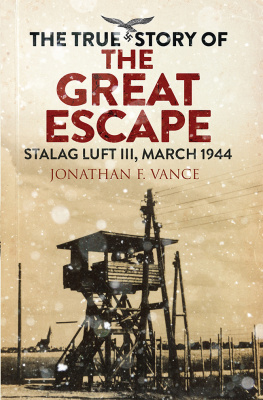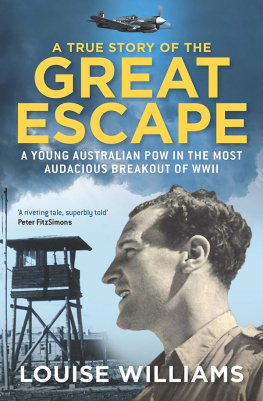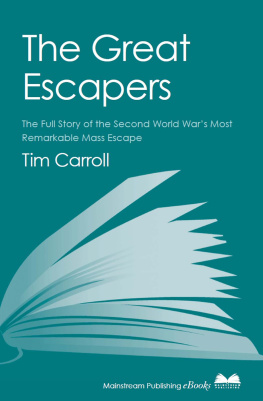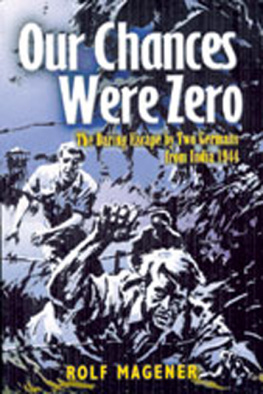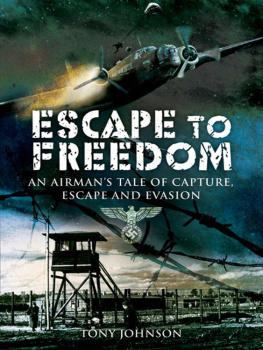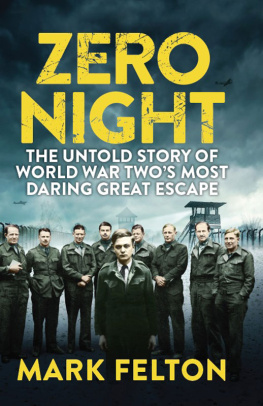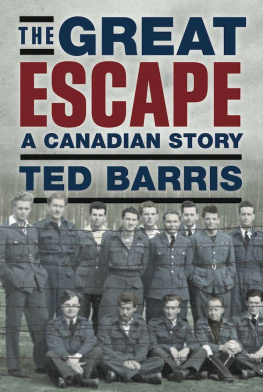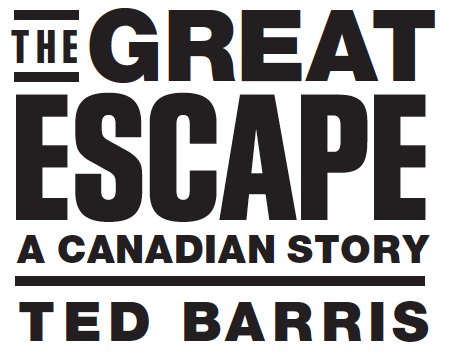Copyright
Copyright Ted Barris, 2013
All rights reserved. No part of this work may be reproduced or transmitted in any form or by any meansgraphic, electronic, or mechanical, including photocopying, recording, taping, or information storage and retrieval systemswithout the prior written permission of the publisher, or in the case of photocopying or other reprographic copying, a licence from the Canadian Copyright Licensing Agency.
Library and Archives Canada Cataloguing in Publication
Barris, Ted, author
The great escape : a Canadian story / Ted Barris.
Includes bibliographical references and index.
Issued in print and electronic formats.
isbn 978-1-77102-272-9 (bound). isbn 978-1-77102-474-7 (epub).
1. Stalag Luft III. 2. World War, 1939-1945Prisoners and prisons, German.
3. Prisoners of warCanadaBiography. 4. Prisoners of warGermany
Biography. 5. Prisoner-of-war escapesPolandZagan. 6. World War,
1939-1945Personal narratives, Canadian. I. Title.
d805.5.s73b37 2013 940.54'72430922 c2013-902860-9
c2013-902861-7
Jacket and text design: Gordon Robertson
Jacket image: Tony Pengelly Collection
Endpaper illustrations: Lightfoot Art & Design Inc.
Published by Thomas Allen Publishers,
a division of Thomas Allen & Son Limited,
390 Steelcase Road East,
Markham, Ontario l3r 1g2 Canada
www.thomasallen.ca
We would like to acknowledge funding support from the Ontario Arts Council, an agency of the Government of Ontario.
We acknowledge the support of the Canada Council for the Arts, which last year invested $157 million to bring the arts to Canadians throughout the country.
We acknowledge the Government of Ontario through the Ontario Media Development Corporations Ontario Book Initiative.
We acknowledge the financial support of the Government of Canada through the Canada Book Fund for our publishing activities.
Dedication
To air force veteran Charley Fox and military history
buff Dave Zinkboth gone nowwho challenged me
to properly retell this great, great story.
The author and publisher gratefully acknowledge the permission granted to reproduce the copyright material in this book. Every effort has been made to trace copyright holders and to obtain their permission for the use of copyright material. The publisher apologizes for any errors or omissions and would be grateful if notified of any corrections that should be incorporated in future reprints or editions of this book.
The author would like to acknowledge the following for the use of published and unpublished works as follows:
A Gallant Company, Jonathan F. W. Vance, permission from copyright holder.
Air Force Association video interviews, 1970s and 1989, permission from rights holders National Air Force Museum of Canada, Trenton.
Bonds of Wire, Kingsley Brown, permission from copyright holder Ethel Alle.
Forced March to Freedom, Robert Buckham, permission from copyright holder Nancy Buckham.
Frank Sorensen collection, permission from Glenn, Stephen, and Vicki Sorensen.
Goon in the Block, Don Edy, permission from copyright holder.
In Enemy Hands, Daniel G. Dancocks, permission sought through Hurtig, Random House.
Its All Pensionable Time, George Sweanor, permission from copyright holder.
John Colwell diary, permission from copyright holder Harold Johnstone.
John Weir letters, permission from Mrs. Frances Weir.
Lonesome Road, George Harsh, permission from publisher W. W. Norton, New York.
One Mans War: Sub Lieutenant R. E. Bartlett, RN Fleet Air Arm Pilot, Stuart E. Soward, permission from copyright holder Sheila Soward.
Serving and Surviving: An Airmans Memoirs, John R. Harris, permission from copyright holder.
The Great Escape, Paul Brickhill, permission from rights holders David Higham Associates, UK.
The Great Escape, Stalag Luft III (from the original drawings made by Ley Kenyon 1943), permission from copyright holders RAF Museum, Hendon, UK.
The Tunnel King: The True Story of Wally Floody and the Great Escape, Barbara Hehner, permission from copyright holder.
They Were So Young, Patricia Burns, permission from copyright holder.
Tom, Dick and Harry of Stalag Luft III, Bob Nelson, unpublished manuscript, permission from Sally Hutchison.
Acknowledgements
T HE CONTEMPORARY ROAD to Zagan is nearly as inhospitable and neglected as it must have been in 1942 , when the town became neighbour to a prisoner-of-war camp. Even when I travelled on it in 2010 , most of the one hundred miles of road southeast of Berlin, primarily in western Poland, didnt seem to have ever enjoyed priority status. The post-Soviet-era asphalt was still as patchy, the lanes still as poorly marked, and the rough countryside terrain still encroaching the roadside shoulders right to the road surface as it likely had when the Nazis occupied Poland during the Second World War.
Likewise, the Zagan (the Polish spelling of Sagan) train station at the edge of town looked as if it hadnt enjoyed any remodelling since it was built in the early 1900s. When I walked inside, I could almost see the first wave of Great Escape fugitives hurrying through ticket queues and platform document checks by guards in the morning gloom on March 25 , 1944 , to get aboard the Breslau-to-Berlin express train without raising suspicion. And the treesthe omnipotent pine forest to the southbetween the railway platforms and the prison camp looked as dense and claustrophobic as they must have been to the air force officers trying to escape a generation ago.



